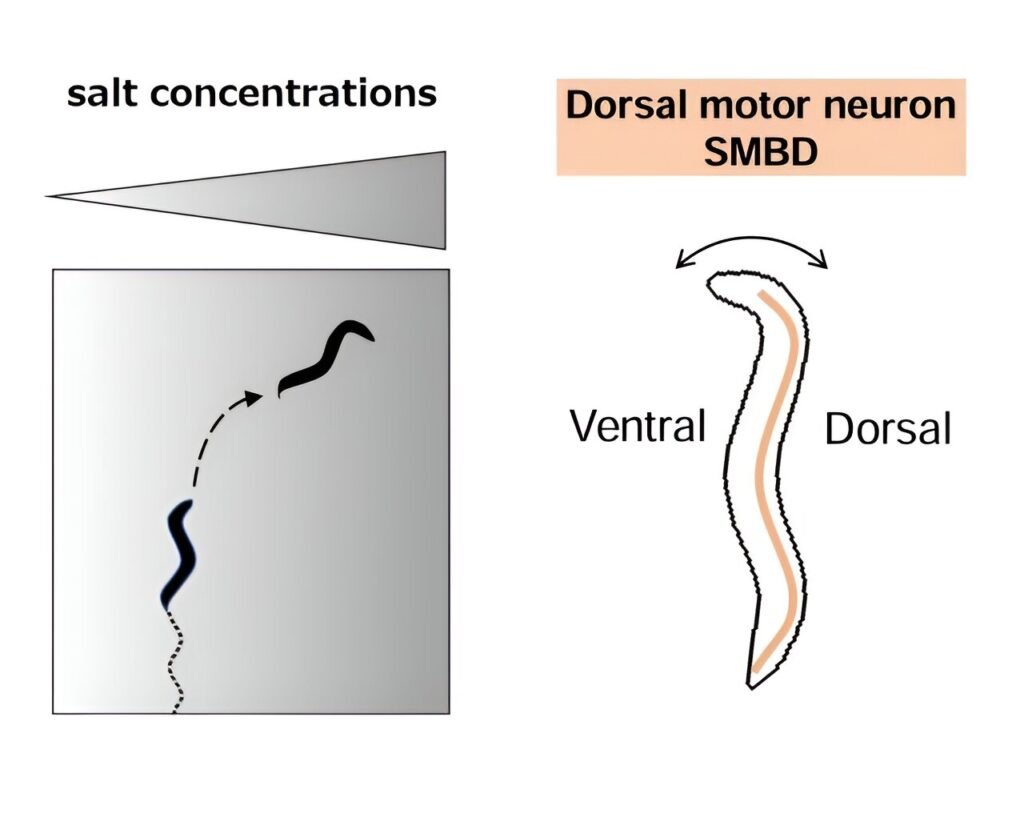Diagram of a nematode turning toward an area of high salinity (left). Diagram of C. elegans and its dorsal (neck) motor neuron, SMBD (right). Credit: Matsumoto et al. 2024
× close
Diagram of a nematode turning toward an area of high salinity (left). Diagram of C. elegans and its dorsal (neck) motor neuron, SMBD (right). Credit: Matsumoto et al. 2024
A joint study by Ayaka Matsumoto and Yuichi Iino from the University of Tokyo demonstrated that a temporary decrease in salt concentration leads to activation of motor neurons in the neck of roundworms, but only during specific stages of their activity. .
Activation adjusts the trajectory of the roundworm toward higher salt concentrations. This discovery pinpoints the neural mechanisms by which roundworms integrate sensory and motor information, and is a first step toward understanding the neural mechanisms of navigation in more complex animals.The research results were published in a magazine Proceedings of the National Academy of Sciences.
It took human civilization thousands of years of concentrated effort to build (somewhat) self-driving cars. However, even the simplest animals can integrate sensory information about their environment and adjust their movements accordingly. Therefore, the integration of sensory information and motor control is one of the most fundamental questions that biologists can address.
The researchers decided to do exactly this using a type of roundworm called Caenorhabditis elegans. A total of 302 neurons in C. elegans have been fully mapped, making it possible to manipulate single neurons and observe their effects.
“The roundworms slowly curve their way toward areas with high salinity,” explains Matsumoto, lead author of the paper. “To control this bending behavior, roundworms need to detect salinity perpendicular to their path of movement. However, roundworms only have a single-point ‘sensor’ that allows them to detect salinity in space. Therefore, the roundworm must be processing temporal changes in salt concentration to recognize the preferred side.”
To investigate this hypothesis, the researchers used a “bobble chip,” a small device that allows the worms to move their heads freely. The researchers then observed how the animals “fixed” in the device responded to increases and decreases in salinity.
Roundworms move around by contracting muscles that run along the long axis of their bodies. As a result, the head swings back and forth between the direction of the stomach (ventral) and the back (dorsal), eventually curving further in the direction it wants to go.
Here, the researchers found that lower salt concentrations activated the dorsal cervical neuron SMBD only during specific phases of its activity, and that its activity was strongly correlated with head shaking. The activation of SMBD with decreasing salinity coincided with the ventral bending of the neck. This suggests that SMBD is detecting lower salt concentrations on the ventral side of the body.
Furthermore, we found that when the SMBD is artificially activated when bending the neck ventrally, the subsequent ventral bending of the neck becomes shallower. Taking these results together, the researchers hypothesized that the SMBD not only detects changes in salinity, but also plays a role in suppressing lateral neck bending at lower salinity. Therefore, it directs nematodes to higher salt concentrations.
“Even though we found that SMBD neurons integrate sensory and motor information, the molecular mechanism of integration remains unclear,” Professor Matsumoto points out for future research.
“We are therefore interested in what happens inside SMBD neurons while sensing changes in salinity or neck movement. We are also interested in what happens inside SMBD neurons while sensing changes in salinity or neck movement. We also I would like to observe the activity of neurons.”
For more information:
Neurosensorimotor integration guiding salinity navigation in Caenorhabditis elegans Proceedings of the National Academy of Sciences (2024). DOI: 10.1073/pnas.2310735121. doi.org/10.1073/pnas.2310735121
Magazine information:
Proceedings of the National Academy of Sciences

